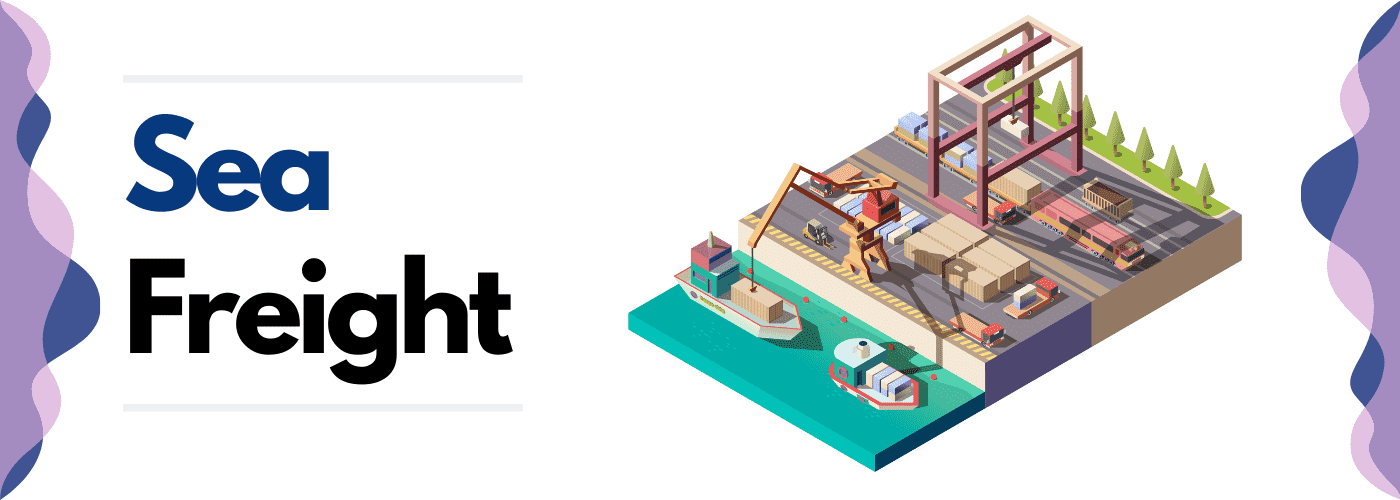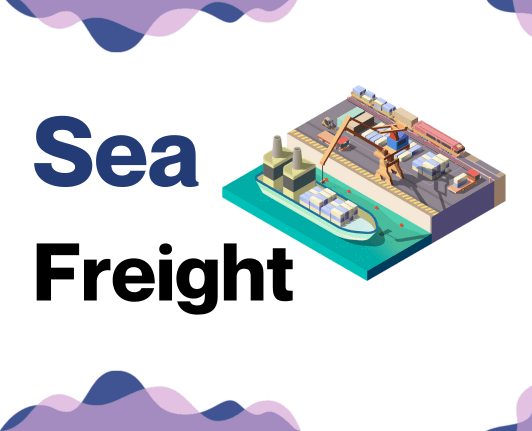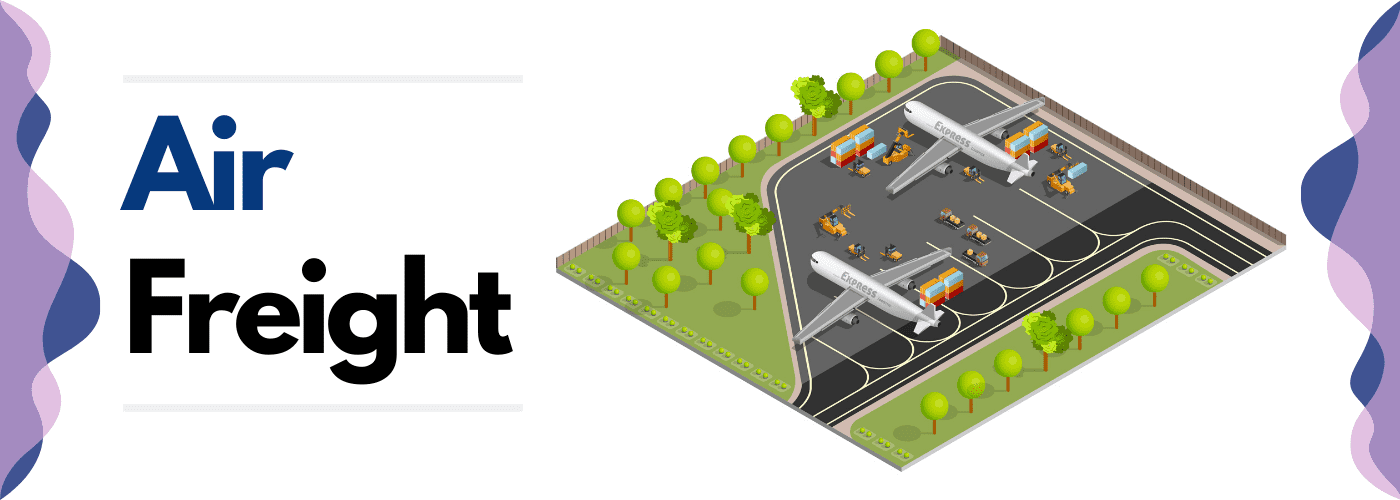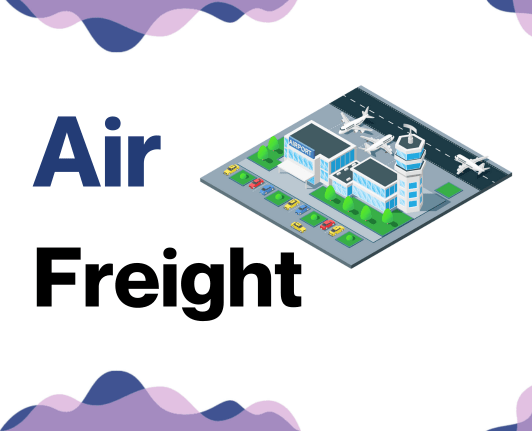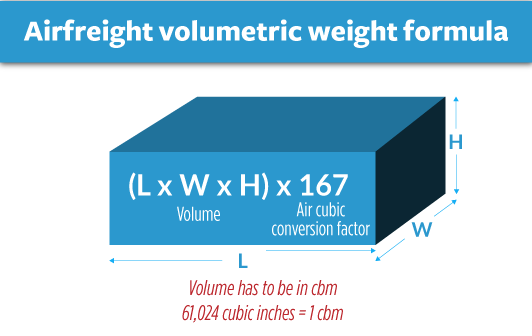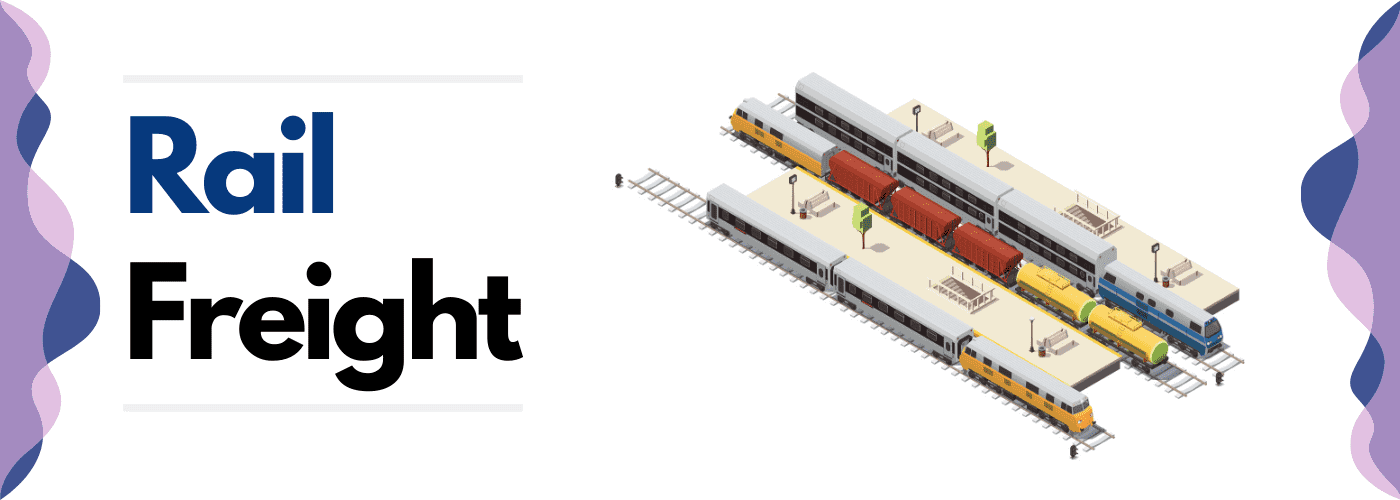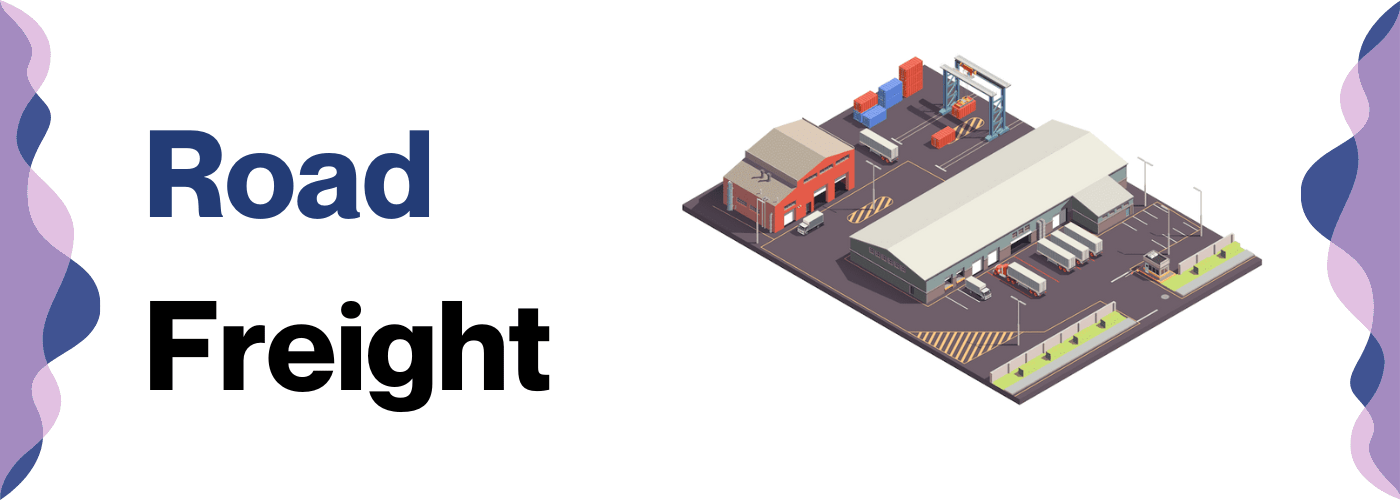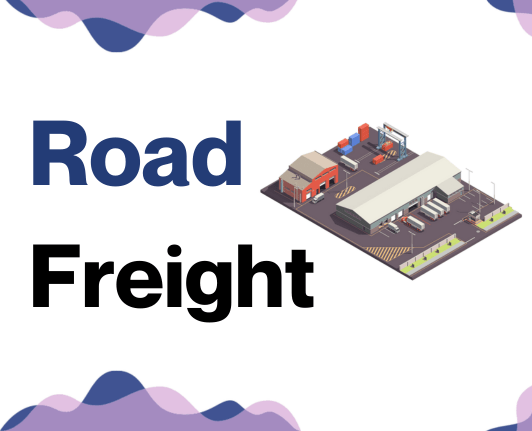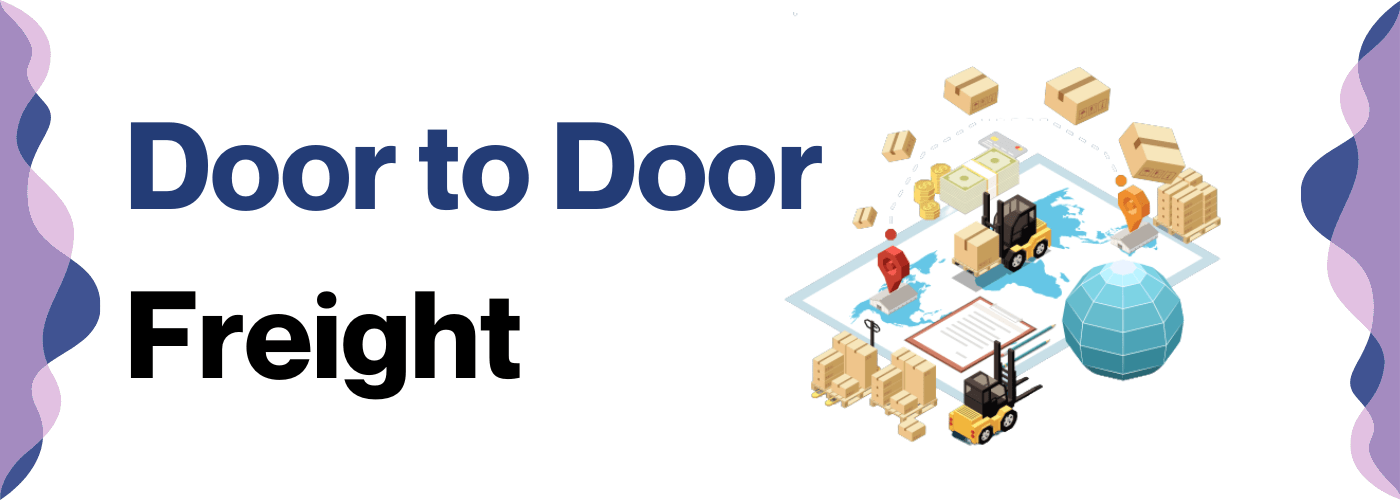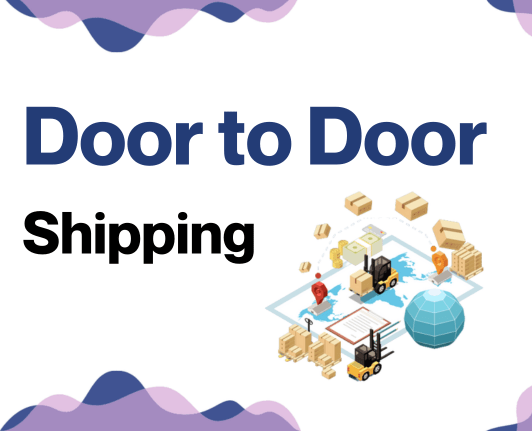Need to ship a crate of tea kettles from London to Vienna and not sure where to start? The world of freight transport, with its complicated rates, transit times, and customs regulations, can appear as daunting as a towering Alpine peak. But don't worry, we've got you covered. This detailed guide will take you step by step through the freight transport process between the UK and Austria.
We'll discuss different types of freight options, break down the customs clearance procedures, explain duties and taxes, and provide business-specific advice to ease your shipping journey. If the process still feels overwhelming, let DocShipper handle it for you! Our commitment is to turn your logistics challenges into successful shipping stories, managing every phase of the journey from start to finish.
Table of Contents
Which are the different modes of transportation between UK and Austria?
Shipping goods between the UK and Austria presents unique challenges. There's distance and border controls to consider, and each transportation option has its own pros and cons. So, what's the best way to get your goods across? We'll look at options like air, sea, road, and rail, offering insights to help you make the right choice. Consider it like choosing between walking, riding a bicycle, a car or a helicopter for a summer trip: each choice comes with its own journey time, cost, and what you can pack. Together, we’ll find the most practical solution for your shipping needs.
How can DocShipper help?
Shipping from the UK to Austria? Let DocShipper simplify the journey for your goods! Our seasoned experts will handle everything - from transport organization to taking the weight of customs clearance off your shoulders. Intrigued? Reach out to us for a free estimate within 24 hours or call our consultants for zero-cost advice!
DocShipper Tip: Ocean freight might be the best solution for you if:
- You're dealing with large quantities or oversized items. Sea freight offers a budget-friendly way to maximize space, a particularly useful option given the UK's extensive port network.
- Your shipment isn't on a tight schedule. Ocean transport typically takes longer than air or rail, but it offers reliability.
- Your supply chain involves key ports, allowing you to take advantage of a wide-reaching network of sea lanes.
Sea freight between UK and Austria
United Kingdom and Austria share a dynamic ocean trade network, connecting their thriving industrial sectors through major bustles like London Gateway and the Port of Antwerp. Indeed, sea freight is your best bet if you're sending large volumes of goods. It may take its sweet time compared to air freight, but it's the kinder choice for your wallet!
Now, let's flip the coin. For many businesses, the route from UK to Austria isn't a walk in the park. Picture trying to tackle a giant map with endless roads and markings, without a guide! Many often find themselves stuck in the maze of custom clearances, paperwork, and the specific dos and don'ts of shipping regulations. But fear not, in this guide, we'll untangle those knots one step at a time. We'll explore best practices and techniques that will turn this complex sea journey into a smoothly sailed ship. Get ready to conquer those shipping blues!
Main shipping ports in UK
Port of Felixstowe
Location and Volume: Located in Suffolk, the eastern coast of the UK, the Port of Felixstowe is an essential maritime gateway, having a shipping volume of around 3.8 million TEUs per year.
Key Trading Partners and Strategic Importance: It plays a critical role in the UK's trade with China, the rest of Asia, and Europe. It's notable for its two deep-water container terminals.
Context for Businesses: If international trade with Asia features highly in your strategy, Felixstowe's comprehensive rail network can expedite inland distribution.
Port of Southampton
Location and Volume: Situated on England's south coast, the Port of Southampton processes close to 1.5 million TEUs annually, making it another vital hub for UK imports and exports.
Key Trading Partners and Strategic Importance: It has significant trade links to North America and Asia. The port hosts the UK's second-largest container terminal and a crucial hub for automotive trade.
Context for Businesses: For businesses in automotive sectors or trading significantly with the Americas, Southampton’s well-connected infrastructure could streamline your logistics chain.
Port of London
Location and Volume: Located alongside the River Thames, the Port of London ranks third regarding the volume of trade, with its shipping volume nearing 53 million tons annually.
Key Trading Partners and Strategic Importance: It's a vital point for trade with the EU, as well as bulk commodities worldwide. The port carries more non-food products than any other UK port.
Context for Businesses: If you're dealing with non-food products, particularly in significant quantities, the Port of London's diverse service offering might align well with your needs.
Port of Liverpool
Location and Volume: The Port of Liverpool, strategically situated in the North West of England, sees annual shipping volumes of over 32 million tons.
Key Trading Partners and Strategic Importance: This port maintains strong trading networks with North America, Ireland, and other European markets. Its central location makes it a prime choice for reaching the UK's northern population centers.
Context for Businesses: If you aim to reach UK markets outside of London efficiently, Liverpool's central position and the well-connected road and rail networks offer an excellent gateway.
Port of Grimsby & Immingham
Location and Volume: Located on the South Bank of the Humber Estuary, the Port of Grimsby & Immingham ships over 60 million tons annually, making it the UK's largest port by tonnage.
Key Trading Partners and Strategic Importance: It's particularly important for trade with Northern Europe, handling mostly energy products, cars, and fresh produce.
Context for Businesses: If you're in the energy, vehicle, or fresh produce sectors, the large capacity, and excellent North European connections make Grimsby & Immingham a prime choice.
Port of Tyne
Location and Volume: The Port of Tyne, situated in Northeast England, it handles around 4.5 million tons of cargo annually.
Key Trading Partners and Strategic Importance: The port mainly facilitates trade with Europe, handling diverse cargoes including cars, containers, and bulk goods.
Context for Businesses: If you operate in the automotive, retail, bulk goods, or have connections to Scandinavia and the Baltic states, the Port of Tyne’s high functionality may enhance your shipping operations.
Main shipping ports in Austria
Port of Vienna
Location and Volume: Located on the banks of the Danube River, the Port of Vienna is indispensable for trade within Europe, with a shipping volume of nearly 12 million tons annually.
Key Trading Partners and Strategic Importance: Germany, Hungary, the Netherlands, and Slovakia are primary trading partners. The port's strategic location makes it a pivotal junction for goods transiting from Baltic, North, and Black Sea regions.
Context for Businesses: If you're aiming to expand your trade within the European market, the Port of Vienna may be instrumental in your logistics strategy, given its excellent connections with key European trading routes and inland waterways.
Port of Enns
Location and Volume: Situated strategically in the city of Enns, this port is crucial for handling heavy and bulk goods, managing approximately 2 million tons of freight annually.
Key Trading Partners and Strategic Importance: The port's crucial trading partners are Germany, Netherlands, and Hungary. Its extensive intermodal transportation network underlines its strategic significance.
Context for Businesses: If your business is involved in heavy industry or construction sectors, the Port of Enns might be a key consideration in your shipping strategy because of its specialized handling facilities.
Port of Linz
Location and Volume: Located in the heartland of Austria, the Port of Linz is a vital freight hub, processing close to 4 million tons of cargo per year.
Key Trading Partners and Strategic Importance: Trading partners range from neighboring European countries to Asia and North America. The port specializes in handling project and heavy lift cargoes, boosting its strategic importance.
Context for Businesses: If your business requires specialized handling for heavy or project cargoes, considering the Port of Linz for your logistics could give you the advantage of specialized handling facilities and broad trading partners.
Port of Krems
Location and Volume: Nestled along the Danube River, the Port of Krems facilitates trade across Eastern Europe with an annual cargo throughput of 1.8 million tons.
Key Trading Partners and Strategic Importance: Key trading partners include Germany, Slovakia, and Romania. Its strategic significance lies in the port's modern logistics and multifunctional freight terminals.
Context for Businesses: If your business strategy involves penetrating Eastern European markets, the Port of Krems' excellent infrastructure and strategic location could be vital to your logistics plans.
Please note: while these ports are significant for specific trading routes and purposes, it's essential to consider your business's specific needs, the nature of your goods, and possible trade routes when determining the best fit for your shipping strategy. Austria’s network of well-connected inland ports offers a range of options to ensure the efficient shipping of your goods.
Should I choose FCL or LCL when shipping between UK and Austria?
When shipping goods between the UK and Austria, whether to choose Full Container Load (FCL) or Less-than Container Load (LCL), aka consolidation, can feel like a tough call. The right decision optimizes costs, ticks the time clock favorably, and paves the way for a stress-free shipping process. Below, we untangle these two main sea freight options, comparing and contrasting them to equip you with the knowledge needed to make an informed decision that perfectly aligns with your specific shipping requirements. Let's embark on this strategic journey.
LCL: Less than Container Load
Definition: Less than Container Load (LCL) shipping is a method of transporting goods that don't fill up an entire container. It's a cost-effective solution where your cargo is consolidated with other shippers' goods into one container for the journey.
When to Use: LCL is the ideal option when your cargo size is less than 13/14/15 Cubic Meter (CBM), providing the flexibility of shipping low volumes without waiting to fill a container.
Example: A furniture manufacturer in the UK is looking to ship 10 CBM of dining chairs to a client in Austria. Given the volume, the manufacturer would opt for an LCL shipment, ensuring goods are transported in a timely and cost-effective manner.
Cost Implications: LCL freight is generally priced per CBM, so you'll only pay for the space your goods occupy in the container. While per CBM costs can be higher when compared with Full Container Load (FCL) shipping, the overall cost is usually lower for smaller volumes, eliminating the need to wait for enough goods to fill a container. It's important to request an LCL shipping quote from your freight forwarder to understand the full cost implications.
FCL: Full Container Load
Definition: Full Container Load (FCL) shipping is an option in sea freight where a 20'ft or 40'ft container is booked and used exclusively by one shipper.
When to Use: FCL shipping is typically the most cost-effective choice for cargo more than 13/14/15 CBM, for reasons of both economy and safety. Since the FCL container is sealed from origin to destination, the risk of damage to the goods is significantly reduced.
Example: For example, a furniture manufacturer in Leeds with a large shipment, say 15 CBM, destined for salons in Vienna might choose FCL shipping. They will get an FCL shipping quote, book an entire 20'ft container, and enjoy peace of mind knowing their goods won't be handled until reaching their destination.
Cost Implications: While the absolute cost of FCL is higher due to the booking of an entire container, the cost per unit of cargo is significantly reduced with high volume shipments. This economic efficiency coupled with added security makes it a preferred choice for high volume shippers.
Unlock hassle-free shipping
Facing a tough choice between consolidation or full container for your UK-Austria shipment? Allow DocShipper, your reliable freight forwarder, to simplify the process. Our ocean freight experts consider factors like volume, weight, and type of goods to help decide the best shipping method. With us, cargo shipping becomes a breeze. Interested? Contact us for a free, no-obligation shipping estimate. Let's make freight forwarder solutions easy!
How long does sea freight take between UK and Austria?
Since Austria is a landlocked country, it is difficult to estimate exact transit time between China and Austria. Transit times are also driven by factors like the specific ports of loading and discharge, the weight of the cargo, and nature of the goods. For an accurate and tailored quote best suited to your specific needs, it's recommended to reach out to a freight forwarder like DocShipper.
How much does it cost to ship a container between UK and Austria?
Understanding ocean freight rates between UK and Austria is a dynamic aspect of the shipping process, complex yet vital. No exact price fits all, as costs are affected by variables like Point of Loading, Point of Destination, carrier selection, nature of goods, and market fluctuations. However, broadly speaking, costs per Cubic Meter (CBM) can range significantly. That's where our experts come into play. They analyze your unique scenario, optimizing each factor to offer competitive shipping costs and tailor-made quotations. Rest assured, we're committed to making your shipping journey as cost-effective and hassle-free as possible.
Special transportation services
Out of Gauge (OOG) Container
Definition: Out of Gauge (OOG) containers, also known as open-top or flat rack containers, are specially designed to fit cargo that doesn't comply with normal shipping standards due to size or shape.
Suitable for: Items that are too large to fit in standard containers- such as machinery, industrial equipment, or construction materials.
Examples: Wind turbine blades, propellers, large vehicles or irregularly shaped machinery parts.
Why it might be the best choice for you: If your business specializes in transporting large machinery or outsized cargo, OOG container shipping ensures secure and regulated transportation.
Break Bulk
Definition: Break bulk refers to the transportation method where goods are loaded individually rather than in shipping containers. The term break indicates the process where the cargo is broken down into smaller sizes for ease of handling.
Suitable for: For items that can't be containerized due to their size or the quantity being shipped is not sufficient to fill a full container.
Examples: Construction equipment, timber, steel slabs, or large gears.
Why it might be the best choice for you: Choose break bulk shipping when you're dealing with large quantities of loose cargo load that don't conform to standard container sizes.
Dry Bulk
Definition: Dry bulk shipping refers to the movement of homogenous raw commodities in large quantities. These goods are often poured with a shovel or scoop, as opposed to being loaded in a specific way individual by individual.
Suitable for: Commodities like coal, grains, or sand that can be shipped in vast amounts.
Examples: Iron ore, fertilizers, or steel products.
Why it might be the best choice for you: If your company ships large quantities of uniform raw materials, dry bulk shipping can be the most economical option.
Roll-on/Roll-off (Ro-Ro)
Definition: Roll-on/Roll-off (Ro-Ro) shipping means goods are driven onto a ro-ro vessel and secured inside, then driven off at the destination. This type of shipping is primarily used for transportation of anything on wheels.
Suitable for: Cars, trucks, the transport of trailers, and machinery.
Examples: Vehicles, agricultural machinery, or heavy plant equipment.
Why it might be the best choice for you: Opt for Ro-Ro shipping when dealing with wheeled cargo and vehicles as it is the most efficient and cost-effective method in such cases.
Reefer Containers
Definition: Reefer containers are refrigerated shipping containers for goods requiring temperature-controlled handling.
Suitable for: Perishable goods, temperature-sensitive pharmaceuticals, and other items requiring a controlled environment during transit.
Examples: Fruits, vegetables, meat, dairy products, or medicines.
Why it might be the best choice for you: If your business involves shipping perishable or temperature-sensitive goods, reefer containers provide the required temperature control, maintaining the product's integrity during transit.
Regardless of your specific shipping needs between the UK and Austria, or the kind of goods you handle, DocShipper offers a range of sea freight solutions tailored to your business needs. Contact us today for a free shipping quote in less than 24 hours.
DocShipper Tip: Air freight might be the best solution for you if:
- You're facing tight deadlines or need rapid delivery. Air freight is your quickest option, which aligns well with the fast-paced business environment.
- Your shipment is relatively small, under 2 CBM. Air freight is ideal for these more compact loads.
- Your cargo's destination isn't easily reached via sea or rail. This makes air freight a viable option, especially given the extensive network of airports available.
Air freight between UK and Austria
For fast, reliable delivery of small yet valuable loads between the UK and Austria, air freight stands as your go-to solution. Imagine sending an expensive, delicate piece of jewellery - with air freight, it's like putting it in a protected, speedy bubble, getting it to its destination with minimal fuss.
However, beware the common pitfalls. Missteps in weight estimation (like forgetting to use the correct weight formula) can lead to costly surprises. Like overlooking the necessary precautions when frying a turkey for the first time, skipping the groundwork in air freight can lead to a financial 'burn'. This guide will fortify you with best practices for avoiding these costly errors.
Air Cargo vs Express Air Freight: How should I ship?
Unsure whether to roll with air cargo or express freight cargo for your UK to Austria shipment? Here's the skinny: air cargo teams up with passenger airlines, squeezing your cargo into free spaces, while express freight nabs its own plane for a speedier delivery. Let's delve in to decide the best choice for your precious cargo, considering the benefits and trade-offs each one brings.
Should I choose Air Cargo between UK and Austria?
Opting for air cargo between the UK and Austria provides an advantageous avenue for your business, especially when your shipments exceed 100/150 kg (220/330 lbs). Firms like British Airways or Austrian Airlines, renowned for their reliable air cargo services, offer competitive rates that accommodate varying budget sizes. While air freight tends to follow fixed schedules leading to slightly longer transit times, the cost-effectiveness and dependability of this option underscore its appeal. Balancing your budget with your shipment needs could make air cargo the fitting choice.
Should I choose Express Air Freight between UK and Austria?
Express air freight, carried by specialized planes with zero passengers, like FedEx, UPS, or DHL, is your go-to service for swift, secure delivery of goods under 1 CBM or weighing 100/150 kg (220/330 lbs). These express couriers offer premium services, including real-time tracking, ensuring your cargo's status is just a click away. So, if reliability and speed are your priorities, especially for small or time-sensitive shipments, choosing express air freight between the UK and Austria could be an optimal solution for your business.
Main international airports in UK
London Heathrow Airport
Cargo Volume: With a massive cargo movement of over 1.2 million tonnes per year, it is the busiest airport in the UK.
Key Trading Partners: The airport has strong trade links with the USA, Asia, and the European Union.
Strategic Importance: Positioned in the economic heartland of the country, Heathrow serves as a crucial hub for businesses in the UK and around the globe.
Notable Features: It has 2 parallel runways and 5 operational terminals, making it highly equipped to handle significant cargo traffic.
For Your Business: With its massive cargo handling capacity and excellent connectivity, it will ensure reliable and efficient shipping of your goods.
East Midlands Airport
Cargo Volume: It handles around 360,000 tonnes of flown cargo every year.
Key Trading Partners: The airport is instrumental in shipping to and from Europe, As well as significant trade with North America and Asia.
Strategic Importance: It is an essential hub for express freight operators and e-commerce due to its 24/7 operation.
Notable Features: Known as UK's premier hub for mail and express freight, it houses major courier companies like DHL, UPS and Royal Mail.
For Your Business: Its 24-hour operation offers a flexible and time-critical shipping option, making it a great choice for e-commerce businesses and urgent freight needs.
Stansted Airport
Cargo Volume: The airport processes over 250,000 tonnes of air cargo annually.
Key Trading Partners: Trading ties include partners across Europe, North America, and Asia.
Strategic Importance: Located near London, it caters to numerous businesses in the region and boosts the local economy.
Notable Features: It houses the UK's largest single warehouse (approximately 343,000 square feet) used for air freight.
For Your Business: Provides ample space for stockpiling and time-critical cargo deliveries, making it a dependable option for a range of businesses, specifically those with high-volume freight needs.
Manchester Airport
Cargo Volume: Handles over 120,000 tonnes of cargo every year.
Key Trading Partners: Maintains significant trade with the European Union and the USA, along with the Middle East and other parts of Asia.
Strategic Importance: Situated in the North West, it serves as an ideal gateway for businesses operating in the region.
Notable Features: The airport has extensive cargo facilities including an exclusive cargo area - 'World Freight Terminal'.
For Your Business: It offers a wide range of cargo services to meet varying business needs and could be particularly beneficial for businesses located in Northern England.
Belfast International Airport
Cargo Volume: Manages approximately 40,000 tonnes of cargo per year.
Key Trading Partners: Primarily trades with partners in Europe, especially Great Britain.
Strategic Importance: As the principal air freight gateway in Northern Ireland, it's instrumental in regional trade.
Notable Features: It possesses the second longest runway in the UK, capable of accommodating large freight aircraft.
For Your Business: The comprehensive infrastructure and the airport's strategic location make it a suitable choice if you’re seeking to reach markets in Northern Ireland and beyond.
Main international airports in Austria
Vienna International Airport
Cargo Volume: Viena International Airport handles over 295,000 tons of cargo annually.
Key Trading Partners: Major trading partners consist of Germany, USA, and China.
Strategic Importance: As Austria's largest airport, Viena International Airport serves as a crucial cargo hub in Central Europe, providing extensive connections across the globe.
Notable Features: The airport boasts state-of-the-art cargo facilities and a dedicated Cargo Centre, offering advanced capabilities for all types of freight.
For Your Business: If your business typically handles high volumes of cargo or deals with the mentioned key trading partners, Viena International Airport could become an effective addition to your logistics strategy due to its networking strength and diverse freight handling competencies.
Salzburg Airport
Cargo Volume: Salzburg Airport, though smaller than Vienna, handles a significant cargo volume, prominently during the peak tourist season.
Key Trading Partners: Mainly trades with countries like Germany, Italy, the UK, and other European Union countries.
Strategic Importance: Salzburg Airport is strategically located, serving as a gateway to Austria's scenic and industrial locations.
Notable Features: The airport features excellent warehousing and logistics facilities, with a focus on efficiency.
For Your Business: If you prioritize efficient operations and frequent shipping to or from the EU, considering Salzburg Airport in your shipping strategy can be beneficial due to its logistical efficiencies and EU-centric focus.
Linz International Airport
Cargo Volume: Linz International Airport showcases a growing cargo volume, hosting over 50,000 metric tons per year.
Key Trading Partners: Predominantly trades with Germany, but also maintains robust connections with Asia and North America.
Strategic Importance: Linz Airport is a significant nodal point for trade in Upper Austria, appealing for its minimal congestion and faster cargo handling times.
Notable Features: Notably, Linz Airport houses a dedicated cargo terminal and utilizes the latest technology for inventory management and tracking.
For Your Business: For companies seeking swift and timely deliveries, Linz International Airport could play a strong part in your logistical plan with its operational speed and advanced cargo-tracking capabilities.
Innsbruck Airport
Cargo Volume: Although Innsbruck Airport primarily serves passenger flights, it handles a reasonable volume of cargo, specifically during the winter sports season.
Key Trading Partners: Innsbruck Airport chiefly interfaces with Germany, Netherlands, and other EU nations.
Strategic Importance: It's a crucial regional hub, highlighted for its adept handling of temperature-sensitive and sports-related cargo.
Notable Features: The airport is renowned for its robust cold chain management facilities, ensuring secure handling of temperature-sensitive goods.
For Your Business: If you're dealing with specialized or temperature-sensitive freight, leveraging Innsbruck airport in your shipping plan can offer a reliable cold chain, ensuring the integrity of your products.
Graz International Airport
Cargo Volume: Graz airport handles more than 16,000 tons of cargo annually.
Key Trading Partners: Graz primarily trades with the EU countries, and also with China and the US.
Strategic Importance: Located in Styria, it's a major contributor to regional growth, owing to its strong links with manufacturing and tech industries.
Notable Features: The airport houses excellent warehousing facilities and offers specialized handling services, making it adept at tackling freight of all kinds.
For Your Business: If your business is focused on tech industries or requires special freight handling, Graz Airport provides an exceptional infrastructure to support these needs. It can be a strategic choice for enhancing your supply chain efficiency.
How long does air freight take between UK and Austria?
On average, shipping between the UK and Austria by air freight takes roughly 1-3 days. However, this duration isn't absolute, as it hinges on several factors including the specific airports involved, the weight of the consignment, and the nature of the goods being transported. For more personalized estimates and accurate timings, it’s highly recommended to consult with an experienced freight forwarder like DocShipper.
How much does it cost to ship a parcel between UK and Austria with air freight?
Air freight costs between the UK and Austria generally range from £1.50 to £4.50 per kg, but please note that these are very rough estimates. Simply put, providing a one-size-fits-all price isn't feasible due to variables like distance from departure and arrival airports, dimensions and weight of the parcel, and the nature of the goods. But never fret —our expert team commits to providing the best rates for your needs, handcrafting quotes on a case-by-case basis. Interested in accurate, tailored pricing? Reach out and receive a free quote in less than 24 hours.
What is the difference between volumetric and gross weight?
Gross weight refers to the total weight of an item, including its packaging. On the other hand, volumetric weight takes into account the space a package occupies in relation to its weight. These two play a crucial role in air freight shipping.
To calculate gross weight in air cargo, it's pretty straightforward. You measure the total weight of the package including its contents and the packaging itself. For example, if your package, with everything inside it, weighs 20 kgs, that’s your gross weight (approx. 44 lbs).
Calculating volumetric weight involves a bit more math. It's determined by multiplying the length, width, and height (in centimeters) of your package and then dividing the result by 5000 for air cargo, and 6000 for express air freight.
If you have a box that's 50cm long, 40cm wide, and 30cm high, its volumetric weight would be 504030/5000 = 12kg (approx. 26.45 lbs).
Here's why they matter: freight charges are usually based on the higher weight between gross and volumetric weight. This method ensures freight companies stay profitable - whether you're shipping dense, heavy products, or lightweight, bulky items. Let’s say you’re shipping that 20 kg item we just discussed. While its gross weight is greater, you would still be charged based on a weight of 20 kg, the higher of the two. In pounds, you'll get charged for approximately 44 lbs.
DocShipper tip: Rail freight might be the best solution for you if:
- You are looking for a cost-effective transportation method for large volumes.
- Your shipping route is well-connected by rail, providing a reliable and environmentally friendly option.
- Your cargo's destination and origin are near rail terminals, minimizing the need for additional road transportation.
Rail freight between UK and Austria
Did you know that the rail freight connection between the UK and Austria might be older than your grandma's secret cake recipe? Established during the Industrial Revolution, it weaves an intriguing tale of cooperation and trade dynamism. Anchoring the economies of Belgium, Germany, and the Netherlands along the way, it traditionally transports goods such as machinery, chemicals and manufactured products.
This rail route, while slower than air, offers a cost-effective freight alternative that has fostered resilient UK-Austria trade bonds for centuries. But beware! Customs procedures are as complex as Austrian strudel, with potential challenges like regulatory discrepancies and documentation issues.
The time, it seems, has come to clickety-clack down the track! Is rail freight your cup of British tea, or are crates overhead more your style? Maybe it's time to dig deeper, unraveling whether rail freight matches your unique shipping requirements.
What are the main train stations between UK and Austria?
London Gateway
This major rail freight terminal, situated in London, is one of the busiest in the United Kingdom. It is strategically important due to its close proximity to the largest consumer markets in the UK. It supports large cargo volumes and has strong rail connections to many regional centers. For your business, this means quicker transit times, reducing the overall supply chain costs.
Daventry International Rail Freight Terminal (DIRFT)
Located in Northamptonshire, DIRFT supports major rail freight with strategic connections to all parts of the UK. It's especially prominent in trade with European partners. DIRFT handles a large cargo volume and provides multimodal cargo handling facilities. Leveraging DIRFT would provide your business with a gateway to other parts of the UK and mainland Europe.
Felixstowe
Known as Britain's busiest container port, Felixstowe also provides rail freight services to major hubs in the country. It is strategically vital due to its direct rail services to 17 inland terminals. High cargo volumes and excellent links to European trading partners make Felixstowe a well-placed hub for your business.
Hams Hall
In the West Midlands, Hams Hall is an international rail freight terminal with superb connectivity to the rest of the UK's rail network. It handles large cargo volumes and is strategically positioned near the motorway network. For your business, Hams Hall means connectivity, expansion, and broad access to the UK markets.
On the other hand, Austria boasts numerous efficient and bustling rail freight terminals. Here are the key ones to consider for your business:
Brennersee Terminal
This terminal acts as the main transport artery between North and South Europe. It handles a significant load of cargo, thanks to its strategic importance in connecting Italian seaports with Austria's core inland region. For your business, Brennersee Terminal offers efficient, central European rail connectivity.
Linz Terminal
Situated on the Danube River, this terminal is a dense freight transport hub that plays a crucial role for North-South and East-West transport. Its strategic location allows for multimodal transportation possibilities. If your business requires broad, pan-European access, Linz Terminal might be the best fit for you.
Vienna South Terminal (Südbahnhof)
Vienna South is large, handling major rail freight volume. It has a strategic location, with expansive rail networks to eastern and southeastern Europe. Utilizing Vienna South Terminal would enable your business to connect with a multitude of European trading partners.
Wels Terminal
Known as a transshipment center, Wels is a pivot for international rail-road transport. The terminal's broad logistics services, coupled with its strategic position, offer tremendous market reach. For expanding businesses like yours, Wels could serve as an effective, efficient hub for both incoming and outgoing shipments across Europe.
DocShipper tip: Road freight might be the best solution for you if:
- You're seeking a budget-friendly solution for shorter hauls. Road freight often comes out on top in terms of cost-effectiveness and speed for these kinds of distances.
- Your end destination is either within your own continent or just across the border. For such regional or intra-continental shipments, road freight is typically the most direct and rapid method.
- Your cargo has unique dimensions or shapes. The adaptability of trucking allows for a wide range of goods that may not conform to the size limitations of sea or air transport.
Trucking between UK and Austria
Continuing your journey from the UK to Austria, let's hit the road with cross-border trucking services. With quick transit times often around 72 hours, it's an enticing option. The routes are quite direct, although keep in mind seasonal road conditions, like winter snow in the Alps. Compared to other methods, road freight is typically cheaper but not as swift as air freight. This mode is efficient and cost-effective, but the balancing act is between time and money. If you're aiming for the compromise between speed and cost, then trucking services could be your winning choice. Providing flexibility with door-to-door delivery, it's a smooth ride for your cargo.
What if I can’t fill a truck between UK and Austria?
When it comes to transporting goods between the UK and Austria, understanding the distinction between LTL (Less than Truckload) and FTL (Full Truckload) freight is crucial. This knowledge can prove to be a business game-changer, offering a balance of flexibility, cost-effectiveness, and efficiency that tailors to your specific shipping needs. Let's dive further to help you make the best choice.
LTL: Less than Truck Load
Let's demystify LTL or Less than Truckload shipping. This type of freight service is ideal when you don't have enough cargo to fill an entire truckload. Say, for instance, your business needs to ship 10 CBM of electronics from the UK to Austria, you'd be best opting for LTL. This way, your shipment shares the truck space with others’ goods, which results in cost savings and improved efficiency, especially fruitful for smaller shipments.
Now, let's concise it into decisive pointers on when to use LTL:
1. Your shipment volume ranges between 1 to 14 CBM.
2. You're focusing on cost-efficiency over speed.
3. Regular shipment frequency is not an issue.
4. Your cargo can be conveniently loaded and unloaded.
5. Fragile or high-value items are minimal in your figurative logistics basket.
LTL freight is a customizable and flexible solution for the right situations. We hope this helped you in strategizing your UK to Austria LTL shipment.
FTL: Full Truck Load
FTL, or Full Truck Load, is a shipping option ideal for sizable freight, where you fill an entire truck with your goods. It's your go-to choice when factors like time, safety, and the nature of your cargo demand exclusive use of a truck. Imagine your furniture manufacturing business in the UK has an order of 30 CBM (Cubic Meters) to be shipped to a major retailer in Austria. Choosing an FTL freight would ensure your shipment will remain in the same vehicle from start to end, reducing loading and unloading risks.
Here are some indications for when FTL may be the right decision:
1. If your cargo fills more than half a truck, consider going all in with FTL shipment.
2. Time-sensitive deliveries often prefer FTL, to avoid delays from other cargo pickups or drop-offs.
3. For fragile or high-value goods, FTL prevents damages from other goods, since your shipment would be the only one in the truck.
4. If your goods need a special type of vehicle or equipment for transportation, it's FTL that wears the crown.
Make a smart choice for your shipment by weighing your specific needs and volume.
What are the main routes between UK and Austria?
The journey by road between the UK and Austria is a voyage through some of Europe's most dynamic hubs. From London, you'd likely traverse the Channel Tunnel and onto France's Autoroute A16, zipping through the picturesque Belgian cities of Bruges and Antwerp on the E40. Germany's Autobahn A3 is a crucial leg of the trip, where cities like Frankfurt and Nuremberg serve as significant waypoints. Finally, upon reaching Austria, the West Autobahn (A1) stands as your main gateway to key destinations like Linz and Vienna. Weather and roadworks can influence the journey durations, so planning and staying informed is crucial.
What are the road transit times between UK and Austria?
Transit times for road transport between the UK and Austria typically averages 1 to 3 days. However, bear in mind, this duration is approximate as it can be influenced by unpredictable factors such as traffic conditions, varying circulation rules, and occasional poor road quality, for instance during adverse weather situations in Alpine regions. Remember, these are just guidelines, and you can reach out to us anytime for a precise cross-border freight quote within 24 hours.
How much does trucking cost between UK and Austria?
Nailing an exact price for truck shipping from the UK to Austria? Tougher than herding cats! Just like air and sea freight, costs can juggle like a circus act. But hang tight! Each quote is a unique snowflake, crafted to give you the best rate. So grab a cuppa, and let's solve this grand financial puzzle, together!
DocShipper tip: Door to Door might be the best solution for you if:
- You prioritize ease and a hassle-free shipping experience. Door-to-door services manage the entire process, from collection to final delivery.
- You appreciate the efficiency of having one dedicated contact. With door-to-door, a single agent is responsible for overseeing all elements of your shipment.
- You want to limit the number of times your cargo is transferred. Door-to-door services minimize the switches between various transport methods, lowering the chances of damage or loss.
Door to door between UK and Austria
Dig into the convenience of Door-to-Door shipping between the UK and Austria, a method where we handle your cargo from pickup to final delivery. Imagine sidestepping hassles over transport coordination, customs, and documentation; that's the simplicity we're talking about. So, sit back, take a breather, and let us unpack the benefits of this seamless service for you. Ready? Let's dive in!
Overview – Door to Door
Eliminating the stress of shipping goods between the UK and Austria has never been easier with door-to-door service. Say goodbye to frustrations and concerns over logistics and customs – we handle it all, making it a highly recommended solution among DocShipper clients. While it does come with slightly higher costs, the peace of mind offered offsets it. With door-to-door, complexities become our concern, not yours, as we ensure safe, efficient transport of your merchandise. Stay in the know without the hassle - that's stress-free logistics!
Why should I use a Door to Door service between UK and Austria?
Struggling to find gray hairs on your head? Keep it that way by opting for a Door to Door service from the UK to Austria. Not convinced? Let's march right into five compelling reasons why this might become your shipping method of choice.
1. First, say goodbye to the logistic hassles. No need to hire separate transportation for collection and delivery, the Door to Door service ensures your goods are picked up from your place and delivered directly to the destination. This leaves you with more time to focus on other aspects of your business, rather than on shipment coordination.
2. Secondly, have urgent shipments on the line? Door to Door services often work on precise schedules, delivering your goods in a timely fashion. This service tends to expedite the delivery process, making it ideal for time-sensitive shipments.
3. Did we mention specialized care? That's the third reason. Whether you have a fragile antique or complex machinery, the Door to Door service offers enhanced care and attention through a single handling system, reducing the risk of damages.
4. Now, quatre, or as we pros call it- four. Relieve yourself from the pain of trucking duties. The service handles everything, from the departing port up until the goods reach their final destination. No more dealing with various trucking companies or worrying about last-mile delivery.
5. Lastly, it's the ultimate convenience package. It eliminates interaction with multiple service providers along the supply chain, reduces paperwork, and accelerates import-export formalities.
In a nutshell, Door to Door service is convenience, reliability, and peace of mind, gift-wrapped into one. Now, combine all these five reasons and tell us- who wouldn't want that?
DocShipper – Door to Door specialist between UK and Austria
Experience stress-free, door-to-door shipping from the UK to Austria with DocShipper. We manage A-to-Z logistics: from safe packing to customs clearance across all modes of transportation. Rapid estimates, free of charge, within 24 hours. Plus, enjoy personalized service with a dedicated Account Executive. Reach out today and leave the logistics to us. Start now for a burden-free international shipping experience.
Customs clearance in Austria for goods imported from UK
Customs clearance is the crucial step where your goods get officially approved to enter Austria from the UK. It's a maze, often lined with unforeseen expenses and conditions that could lead to your shipment getting stuck at the border. Understanding customs duties, taxes, quotas, and licenses is key. Navigating this labyrinth might seem daunting, but don't be put off. The forthcoming sections of our guide will lead you through, simplifying the process. But remember, we at DocShipper are experts in making this journey smoother. Need an estimate for your project? Share the origin of your goods, their value, and the HS Code – we'll work out the rest for you. Let us be your guiding light in the murky world of customs clearance!
How to calculate duties & taxes when importing from UK to Austria?
Unraveling the complex task of estimating duties and taxes when importing goods from the UK to Austria can feel like attempting a particularly challenging jigsaw puzzle. Yet, with a clear understanding of the key factors involved - the country of origin, HS Code, Customs Value, Applicable Tariff Rate and additional taxes or fees - it becomes a manageable task. Imagine it as piecing together a story about your goods.
The first chapter of this story involves identifying the birthplace of your goods – the country where they were manufactured or produced. This forms the foundational understanding for the rest of the calculations for your import duties and taxes.
Step 1 - Identify the Country of Origin
Identifying the country of origin can seem self-evident, but it is, in fact, a significant preliminary step in estimating duties and taxes.
Firstly, it's key in determining product classification which, in turn, forms the basis for acquiring your crucial HS code. Secondly, it unveils vital information about any existing bi-lateral trade agreements between UK and Austria which can hugely impact the customs duties you'd be subjected to. Thirdly, different countries have varied rules around valuation methods which directly affects your import duty. Fourthly, it brings to light any relevant import restrictions. Finally, but not least, the country of origin sometimes stipulates the documentation needed during clearance.
Speaking of trade agreements – UK and Austria, like other EU countries, have agreed to remove customs duties on a range of goods under the Brexit Trade Agreement. One such benefit is the preferential tariff rates on goods, but remember, the goods need to meet the 'rules of origin' criteria to qualify. Be aware that this does not account for VAT and certain goods may still attract excise duties.
Always double-check your product on the UK government’s official website to understand any import restrictions applied. This step often saves headaches down the line, so don't overlook it - it's worth your time.
Step 2 - Find the HS Code of your product
The Harmonized System (HS) Code is an international standardized system of names and numbers to classify traded products. Developed and maintained by the World Customs Organization (WCO), these codes are used for declaring goods being imported or exported around the world. These codes help in determining the duty fees, necessary paperwork and regulations for specific goods.
Typically, your product's supplier handles these codes as they are well-versed with all import regulations and their corresponding HS codes. It's a good idea to solicit this information directly from them.
However, should that not be feasible, you can determine the HS code yourself. Here's a simple step-by-step process:
1. Visit the Harmonized Tariff Schedule link.
2. Use the search bar to type in your product's name.
3. Look at the 'Heading/Subheading' column to find your product's HS code.
It's crucial to note that accuracy is paramount when identifying your HS code. Incorrect classifications can lead to delays, additional inspections, and even potential fines. Always double-check to ensure you've correctly identified the HS code of your product.
Here's an infographic showing you how to read an HS code.
Step 3 - Calculate the Customs Value
Understanding the customs value can certainly make your shipping experience smoother. The customs value isn't just about the price tag of your goods. It's a combination of three major factors: the original cost of your goods, international shipping fees, and any insurance costs - giving us the CIF value.
For example, if you purchased goods worth $1000, paid $200 for shipping, and your insurance cost $50, your customs value would sum up to $1250. This figure is critical as it determines the duties you would be required to pay at Austrian customs. Don't overlook this aspect - it could save your business valuable time and money!
Step 4 - Figure out the applicable Import Tariff
An import tariff refers to a tax imposed on goods when they are transported across international borders. The tariff varies according to the product's classification, which is defined by its Harmonized System (HS) code. In the United Kingdom, the Trade Tariff Lookup tool is used to identify these charges. Here's a step-by-step guide:
1. Head over to the Trade Tariff Lookup Tool - UK Government.
2. Enter your product's HS code and input 'Austria' as the destination.
3. The tool will display the import tariffs applicable to that product.
For example, let's assume that the HS code for your product - a batch of wooden furniture - is 9403.60. The tariff resulting from the tool might be 2.7%. Suppose these goods carry a CIF (Cost, Insurance, and Freight) value of $10,000. The import duty can be calculated as: $10,000 (CIF cost) 2.7% (tariff rate) = $270.
Understanding this tariff is essential as it can significantly impact the total cost of import and consequently, your product's pricing strategy in the Austrian market.
Step 5 - Consider other Import Duties and Taxes
Beyond standard tariffs, shipping goods from the UK to Austria can incur additional duties. For instance, if your goods are luxury items like liquor or tobacco, you may need to pay excise duty. Should your products be subject to anti-dumping legislation, you might face additional taxes.
One crucial charge to factor in is the Value-Added Tax (VAT). Unlike other taxes that apply to the cost price of your goods, VAT applies to the total landed cost - that's the combination of the cost of the goods, the freight and insurance costs, and any import duties paid. In Austria, the standard VAT rate is 20%.
Here's an example (remember this is illustrative, actual rates may vary): Let's say the cost of your goods is $500, the shipping and insurance is $300, and the total import duties amount to $200. The total landed cost will be $1000. The VAT you would have to pay at a rate of 20% would be $200.
So, don't ignore these potential costs. Early planning will definitely go a long way in ensuring smooth and cost-effective shipping for your business.
Step 6 - Calculate the Customs Duties
Calculating customs duties when importing goods from the UK to Austria involves multiple components, including the customs value, Value Added Tax (VAT), anti-dumping taxes, and Excise Duty. Here's your formula:
Duty = Customs Value Duty Rate + VAT (Customs Value + Duty + Excise Duty) + Anti-dumping Tax.
For example, say you're importing goods with a customs value of $1000, a duty rate of 10%, and no VAT. Your calculation would look like this:
$1000 x 0.10 = $100 of Customs Duty.
In scenario two, with a VAT rate of 20%, implement the formula this way:
$1000 x 0.10 = $100 of Customs Duty.
VAT = 20% ($1000 + $100) = $220.
And finally, in a scenario including anti-dumping taxes of $50 and an Excise Duty of $30, here's how to calculate:
$1000 x 0.10 = $100 of Customs Duty.
VAT = 20% ($1000 + $100 +$30) = $226.
Note the anti-dumping tax added separately.
Remember, these can be challenging calculations. DocShipper offers comprehensive customs clearance services worldwide, ensuring you're not overcharged. Don't hesitate to contact us for a free quote within 24 hours. We've got this covered.
Does DocShipper charge customs fees?
DocShipper, as a licensed customs broker in the UK and Austria, is in charge of the customs clearance process. You'll be billed for this service, but not for the actual customs duties and taxes, which are paid directly to the government. To ensure transparency, we'll provide you with all official documents from the customs office, proving that you've only been charged the official rates. Remember, the broker's fee and the customs duty are two different things, much like paying for a courier service, and paying the stamp duty. Hope this clears up any confusion.
Contact Details for Customs Authorities
UK Customs
Official name: Her Majesty's Revenue and Customs (HMRC)
Official website: www.gov.uk/government/
Austria Customs
Official Name: Austrian customs administration (Zollverwaltung)
Official Website: www.bmf.gv.at/zoll.
Required documents for customs clearance
Drowning in a sea of documentation for customs clearance? No worries. It's high time we unpacked four crucial papers: the Bill of Lading, Packing List, Certificate of Origin, and Documents of Conformity (CE standard). Gain valuable insights, ease your process, and keep your goods moving smoothly across borders. We're here to shed some light on your path. Stay tuned!
Bill of Lading
Nailing customs between the UK and Austria starts with understanding the Bill of Lading. It's your golden ticket, marking the transition of ownership of your goods. Think of it as a baton in a relay race; once it's passed, the responsibility shifts. There are two types of Bills of Lading: a paper version that’s couriered or an electronic version, commonly referred to as a telex release. Besides saving trees, the telex release saves time because it's e-mailed to you directly - a godsend when time is money. The nitty-gritty details matter here, though - any discrepancies can hold up the whole process. And if you're shipping by air, the Air Waybill (AWB) is your equivalent document. Key takeaway? Double-check every detail, or better yet, enlist a trusted freight forwarder to manage it for you. It can mean the difference between smooth sailing and choppy waters.
Packing List
Navigating through the world of international shipping can feel like a maze. One crucial guide in this endeavor is your Packing List. Think of it as a compass, allowing customs to navigate your shipment, whether it's sailing seas or dominating the sky between the UK and Austria. As a shipper, precision should be your watchword in drafting this document. It should detail your cargo's content, weight, and dimensions accurately - any discrepancy could lead to a customs hold-up.
For instance, consider your goods are travel-size beauty products. If the Packing List reports 1000 items, but there are 1100 in the box, you've just detoured into delay city. So when fashioning your Packing List, exactness ensures smooth sailing through customs, regardless of whether your goods take the sea or the sky. Remember, the success of your shipment rides on the accuracy of this document.
Commercial Invoice
Crafting your Commercial Invoice for UK-Austria shipping demands precision. It's not just a list of the goods you're shipping—it holds crucial information like the Harmonized System (HS) Codes, the country of origin, and the value of goods in GBP. These details help Austrian customs calculate the applicable duties. An incorrectly filled Commercial Invoice can delay your cargo at customs, right when speed is of the essence.
Pro tip: Align the details of all your shipping docs, including the Bill of Lading, with the Commercial Invoice to reduce discrepancies and ensure smoother shipping. Remember, an accurate and consistent Commercial Invoice can be your secret ally in avoiding customs clearance hiccups!
Certificate of Origin
Navigating customs between the UK and Austria? A critical bit of paperwork you'll need is the Certificate of Origin. This crucial document details where your goods have been manufactured - whether it's ceramics from Stoke-on-Trent or Austrian chocolates. Why does this matter? It can unlock preferential customs duty rates, potentially saving your business a bundle in shipping costs. For instance, let's say you're exporting high-end bicycles made in Sheffield. Declaring this on your Certificate of Origin could provide a customs duty advantage thanks to agreements between the UK and Austria. Just imagine cutting your costs while staying lawful and transparent. It's a win-win! So, accurately mentioning the country of manufacture can be more beneficial than you first guessed, making the Certificate of Origin a document not to underestimate.
Certificate of Conformity (CE standard)
Keeping tabs on compliance is crucial when shipping between the UK and Austria, and the Certificate of Conformity plays a key role. This document signifies that your product aligns with the CE standard, a requirement for accessing the European market. Although both revolve around quality, don't confuse it with quality assurance. This is not a stamp of approval for the product's value or performance, but a conformity marker for safety and environmental standards.
It's akin to the FCC Declaration of Conformity in the US, which ensures electronic devices won't interfere with wireless communication. For UK-based companies, it's important to note that since leaving the EU, the UK has adopted the UKCA marking, which you'll need for local markets. Our advice? Stay up-to-date with the new requirements if you're shipping from the UK. It could save you time, penalties, and potential market exclusion if conformity lapses slip through.
Your EORI number (Economic Operator Registration Identification)
As an international trader, one key to a seamless shipping experience between the UK and Austria is the EORI number. Think about it as your VIP pass through customs - without it, your goods hit a roadblock. Why? This unique identification number is what customs authorities use to track and log your cargo. Here's the crunch: since Brexit, both UK and Austrian entities need an EORI for imports and exports. So, don't snooze on this one! Simply head to your respective customs authority's website (i.e. the UK's HM Revenue & Customs or Austria's Federal Ministry of Finance) to register. Remember, lacking an EORI can delay your shipments and incur penalties, and that's the last thing you need in this fast-paced logistics game.
Get Started with DocShipper
Navigating through customs regulations can be complex, that's why DocShipper is here to streamline the process for you. Say goodbye to tedious paperwork and uncertainty. Our experts handle every step of your UK-Austria shipment's customs clearance. Why wait? Reach out now to enjoy our comprehensive services. Get a free, no-obligation quote within 24 hours!
Prohibited and Restricted items when importing into Austria
Shipping goods to Austria? It's crucial to know which items can land you in hot water. Laws on importation can be finicky, and the last thing you need is a customs hitch. Here's your cheat-sheet on prohibited and restricted items. Let's get you shipping smoothly!
Restricted Products
- Alcohol: You have to apply for an Alcohol License from the Austrian Federal Ministry of Finance.
- Pharmaceuticals: Shipments including medication should have a Pharmaceutical License. This can be obtained from the Austrian Agency for Health and Food Safety.
- Firearms: If you plan to ship firearms, you'll need a Firearms License issued by the Federal Ministry of the Interior.
- Animals and Plants: For shipping live animals, plants, or items derived from these, a specific license from the Federal Ministry of Agriculture, Regions and Tourism is required.
- Radioactive Materials: For shipping radioactive materials, a license from the Austrian Federal Ministry for Climate Action, Environment, Energy, Mobility, Innovation, and Technology must be secured.
- Precious Metals and Stones: In Austria, a permit from the Federal Ministry of Finance is needed to import precious metals and stones.
Remember, it's essential to have the appropriate licenses and permits in place before you start shipping your products. This way, you can ensure a smooth and hassle-free shipping process.
Prohibited products
- Narcotics and drugs (unless there's a special permit)
- Explosive materials and ammunition
- Hazardous waste
- Endangered animal and plant species without a CITES permit
- Radioactive substances
- Illegal publications or media potentially harmful to minors
- Over-the-counter medication, unless for personal use
- Counterfeit goods and pirated items
- Unstamped tobacco products
- Certain food products like raw milk or certain animal products from non-EU countries
- Certain agricultural products subject to phytosanitary regulation
- Cultural goods originating in an EU country without a license
Are there any trade agreements between UK and Austria
Yes, there are definitive trade agreements between the UK and Austria. They're governed by the provisions in the EU-UK Trade and Cooperation Agreement that came into effect on January 1, 2021. This allows tariff-free trade on most goods, including your potential shipments. Keep an eye on the ongoing developments around digital trade; the UK is actively pushing for broader agreements, which might open up exciting e-commerce opportunities for your business.
UK - Austria trade and economic relationship
Boasting a relationship forged over centuries, the UK and Austria share a rich tapestry of economic ties. Austria, offering a strategic central European location, serves as a crucial trading partner for the UK.
Renowned for machinery, pharmaceuticals, and its world-class automotive industry, Austrian exports to the UK exceeded £3.6 billion in 2022. Meanwhile, the UK, with its diverse sectors including finance and technology, clocked exports of £2.5 billion to Austria the same year.
Noteworthy milestones can be traced to the post-WWII era, where the two nations began rebuilding their economies together, forging robust ties in the process. Major commodities that navigate this trade route encompass a gamut of goods, from motor vehicles and pharmaceuticals to vintage wines. Today, UK investment in Austria stands at over £500 million, illustrating the countries' deep-rooted financial connections and mutual reliance for continued economic prosperity.
Your Next Step with DocShipper
Overwhelmed by customs regulations and transit choices for UK-Austria shipping? Let DocShipper simplify your journey. Our bespoke services handle everything, from the initial planning to the final delivery. Say goodbye to shipping stress, and say hello to hassle-free freight. Ready to get started? Contact us today for your shipping needs!
Additional logistics services
Discover comprehensive services that go beyond shipping. With DocShipper, navigate all aspects of the supply chain effortlessly, from warehousing to distribution, ensuring your goods arrive safely every time. Experience the most effective and efficient logistics solutions available today. Let's dive in!
Warehousing and storage
Scored finding a top-notch warehouse in the UK for your goods headed to Austria? Conditions like temperature control crucial to your product's integrity can throw a curveball into the mix. But, don't sweat it! Explore bespoke solutions on our page Warehousing, designed for businesses like yours. Keep your cargo safe, sound, and ready to roll, the Austrian Alps are only a click away!
Packaging and repackaging
From artisan chocolates to industrial machinery, shipping UK to Austria demands top-notch packaging. Your goods' protection matters, and poor packaging can bring costly damage. Trustworthy agents ensure your items, be it fragile, bulky, or oddly-shaped, are aptly packaged and repackaged. Think custom wooden crates for heavy machinery or insulated packaging for artisanal treats. Get it right, avoid the hassle. More info on our dedicated Freight Packaging page.
Cargo insurance
Just as fire insurance shields your property from flames, Cargo Insurance fortifies your shipments against the unpredictable realities of international transport. From lost containers to damaged goods, we've got your back. Think of it as your safety net against the unforeseen. Visit our dedicated Cargo Insurance page for more info.
Supplier Management (Sourcing)
Struggling to source products for your UK-Austria line? DocShipper strides in to ease your stress. We scout for manufacturers in vibrant markets like Asia, East Europe and beyond, then steer the procurement process on your behalf. Say goodbye to language tangles as we bridge the communication gap, paving a smooth route from supplier to buyer. Well-versed in the fine print? You will be with our guidance. For a closer look, jump to our Sourcing Services page.
Personal effects shipping
When moving between the UK and Austria, your cherished, fragile pieces need expert care. Got a bulky statue or antique mirror? Our Personal Effects Shipping service got you covered, ensuring these precious items reach their new home undamaged. Imagine moving your valuable painting without a scratch! Just the peace of mind you need. More info on our dedicated Shipping Personal Belongings page.
Quality Control
Quality control isn't just a perk, it's crucial when shipping from UK to Austria. Meticulous inspections during manufacturing or customization, like checking fabric quality in a textile shipment, can nip issues in the bud. With QC, you safeguard your products, ensuring they meet the exacting standards of both the UK and Austria and avoid costly shipment rejections. Turn to our Quality Inspection for handling it like a pro. More info on our dedicated Quality Inspection page.
Product compliance services
Understanding and meeting product compliance regulations can feel like conquering a challenging maze. Are your goods adhering to all necessary standards for your destination? We've got you covered. Our Product Compliance Services offers laboratory testing to certify your goods meet all regulations to ensure smooth transit. Real-world example? Consider a toy manufacturer ensuring child safety standards. More info on our dedicated Product Compliance Services page.
FAQ | Freight Shipping between UK and Austria | Rates - Transit times - Duties and Taxes
What is the necessary paperwork during shipping between UK and Austria?
As DocShipper, we simplify the shipping process for you. A mandatory document required would either be the bill of lading for sea freight or an airway bill for air freight, which we'll handle on your behalf. Your responsibility would involve providing the packing list and the commercial invoice. Depending on what you're shipping, additional documents like Material Safety Data Sheets (MSDS) and certifications may be required. These documents are crucial as they facilitate the clearance process and help us ensure that your shipment reaches its destination without any hiccups.
Do I need a customs broker while importing in Austria?
Indeed, due to the intricate process and the obligatory details and paperwork involved in interacting with customs authorities, using a customs broker is strongly advised when importing into Austria. We, at DocShipper, are equipped to represent your cargo at customs for the majority of shipments, handling all the complexities on your behalf. This step can greatly streamline your importing process and ensure procedures are followed correctly. That way, you can focus on other critical aspects of your business.
Can air freight be cheaper than sea freight between UK and Austria?
While we can't provide a blanket statement regarding air freight being cheaper than sea freight from the UK to Austria, there's a guide to consider. If your cargo is less than 1.5 Cubic Meters or 300 kg (660 lbs), air freight could potentially be more affordable. However, factors such as the route, weight, and volume of your goods play crucial roles in determining the cost. At DocShipper, our dedication is to ensure you get the most competitive freight option. Our account executives are furnished with the knowledge to distill these costs for you, so you'll get the most optimal solution for your specific needs.
Do I need to pay insurance while importing my goods to Austria?
While we don't impose an obligation for you to purchase insurance when importing goods to Austria, we strongly recommend it. There are various unforeseen circumstances that could lead to the loss, theft, or damage of your goods. Having insurance provides you assurance and financial safety net. Remember, better safe than sorry! Yes, it's an added expense, but it's a small price to pay for peace of mind in knowing that your valuable shipment is protected. At DocShipper, we're all about helping you navigate the complexities of international shipping, and we believe that a well-insured cargo is a step towards a successful, hassle-free transaction.
What is the cheapest way to ship to Austria from UK?
Considering the vicinity of the UK and Austria, the most economical method of shipping goods would typically be via road freight. We at DocShipper leverage our extensive network of trusted trucking partners to ensure your shipment reaches its destination in a cost-effective, reliable manner. However, the optimal method ultimately depends on the specifics of your cargo, such as weight, dimensions, and type. So, we advise an individual assessment for each shipment.
EXW, FOB, or CIF?
Choosing between EXW, FOB, or CIF largely comes down to your relationship with your supplier. Suppliers usually sell under either EXW terms (meaning the goods are delivered at their factory door) or FOB terms (which include all local charges until the origin terminal). Remember, your supplier may not be a logistics expert, so it's beneficial to let a specialized agent like us at DocShipper oversee the international freight and destination process. Regardless of the terms you choose, we offer comprehensive door-to-door services, alleviating any logistic concerns for you.
Goods have arrived at my port in Austria, how do I get them delivered to the final destination?
When we handle your cargo under CIF/CFR incoterms, you'll need to hire a custom broker or freight forwarder to assist with terminal clearance, import payments, and final delivery. Alternatively, we offer a DAP service, taking care of the entire process for you. Check these details with your dedicated account executive to clarify this point.
Does your quotation include all cost?
Absolutely, our quotation incorporates all costs except for duties and taxes at the destination. Remember, you can always request your dedicated account executive to provide an estimate for these, ensuring we don't leave any hidden fees, to eliminate any unexpected charges.

